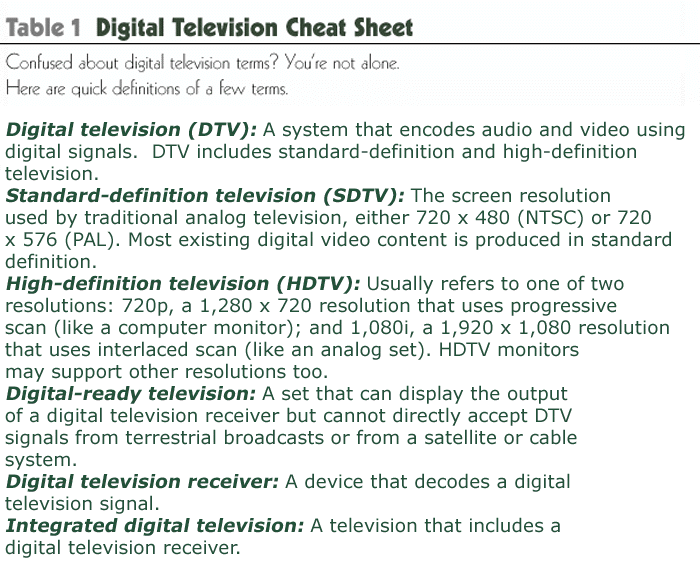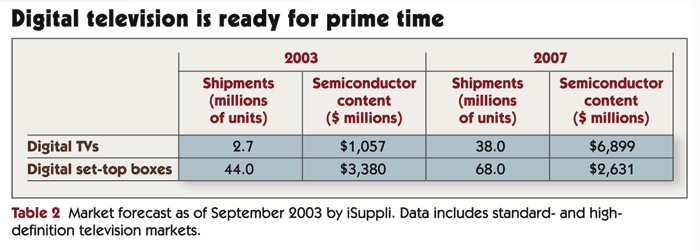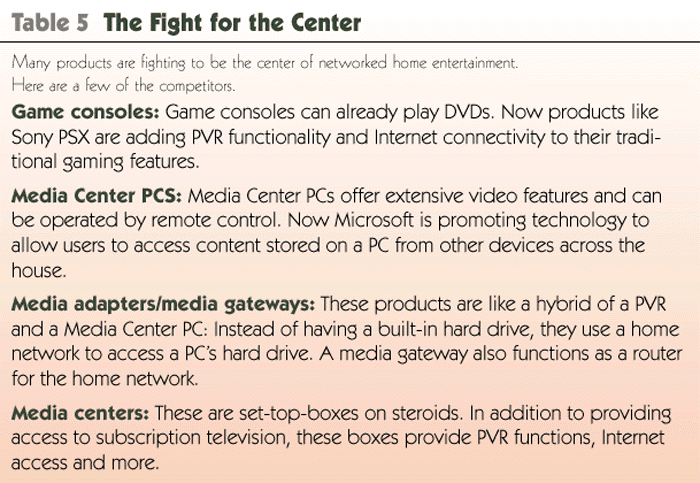A revolution in video technology is under way. The move from analog to digital is reshaping video applications and creating entirely new classes of products and services. The changes affect a broad range of video applications, from portable media players to newscasting to military equipment.
In this article, we focus on the video technology trends in consumer electronics markets, particularly developments in home entertainment gear.
These markets represent by far the largest opportunities for new digital video technologies, and they are the drivers for some of the most exciting technological innovations around.
We also briefly discuss a few other interesting applications, such as surveillance systems.
Here comes the content
Over the past few years there has been an explosion in the availability of digital video entertainment content. This smorgasbord of content has been a key factor behind the growth of consumer digital video markets. Developments in the areas of digital television, optical storage, video compression and networking promise to vastly increase the availability of digital content in the coming years—and to power the growth of digital video markets.
DTV hits the waves
One of the most important recent developments in digital video is digital television (DTV), particularly high-definition television (HDTV). As the name implies, DTV differs from traditional television in that the television signal is digitally encoded. (See Table 1 for more key DTV terms.) Digital television technology has been under development for decades, but it is just now showing signs of life.

Regulations are a key force behind the sudden growth in DTV. Government timelines around the world are forcing broadcasters and manufacturers to move from analog to digital technologies. Berlin has taken the most dramatic step so far: on Aug 4, 2003, the German city shut down all analog TV broadcasts. Berlin's broadcasts are now all-digital.
Other governments are taking a more gradual approach. In a typical example, the United States has dictated that all TVs over 36 inches must be digital-ready this year and that all TV sets must be digital-ready by 2006.
Because of government initiatives, many consumers can now access digital content via terrestrial broadcasts. Typically, high-definition broadcasts are limited to popular prime-time and latenight programming, however.
Consumers have also been able to access digital content via satellite and cable services for several years. Again, only some of this digital content is available in high-definition format. Typically, satellite and cable high-definition programming is limited to ESPN, some HBO programs, and a smattering of movies.

Back to the studio
One reason for the slow transition to DTV—and the particularly slow rollout of HDTV—is that switching from analog to digital television requires massive changes in content production and distribution. Television studios and other production facilities may require significant upgrades in order to make the leap. For example, editing, special-effects, and recording equipment may need upgrades to handle the increased resolutions of high-definition TV.
Digital television also presents distribution challenges. Many cable systems, particularly those in Asia and Latin America, are not capable of transmitting digital television. Upgrading these systems to handle digital signals will require a massive investment. Even in the United States, where digital cable service is widely available, about one-third of cable subscribers have not yet made the switch to digital.
The move to HDTV also strains delivery systems. HDTV requires far more bandwidth than standard-definition television, a requirement that is particularly problematic for satellite TV providers. To squeeze more HDTV programming onto their systems, satellite providers must upgrade to more advanced video compression algorithms (video codecs) and signal modulation schemes.
Although it creates challenges, digital television also creates new opportunities for content distributors. For example, phone companies are beginning to deliver digital video to DSL customers. These video-over-DSL services give phone companies entry into a whole new market and give consumers more ways to access video content.
DVDs Roll Out New Tricks
Of course, DVDs are one of the most important sources of digital video content. Today's DVDs offer only standard-definition content, but high-definition DVDs are on the horizon. Two competing high-definition DVD standards have been proposed. One standard, HD-DVD, would cram high-definition content onto a DVD by using a new video codec. The other standard, BlueRay, would leave the codec unchanged but move from red-laser to blue-laser technology to increase the storage density of the disc.
China decided not to wait for a winner and is developing its own high-definition optical disc standard, the Enhanced Versatile Disk (EVD). Early EVD products will use the same video codec and red-laser technology as current DVDs. Later versions of EVD will use a proprietary Chinese video codec known as AVS. Although the standard is still evolving, early EVD players are expected to begin volume shipments this year, beating BlueRay and HD-DVD to mass production.
Another forthcoming change for optical media is the emergence of inexpensive DVD recorders. The addition of recordability will allow consumers to replace their VCRs with DVD recorders. As shown in Table 3, this will open up a potentially enormous market. Again, multiple standards are competing: in this case, the contenders are DVD-RW, DVD+RW, and DVD-RAM.

The Big Squeeze
The vast majority of existing consumer digital video products—and many emerging products—rely on the MPEG-2 video codec. But MPEG-2 is not efficient enough for forthcoming optical disk standards such as HD-DVD and EVD. More efficient codecs are needed for other digital video products as well. For example, MPEG-2 is not efficient enough to make downloads of movies and other large video files from the Internet practical.
Fortunately, the latest generation of video codecs are up to three times more efficient than MPEG-2. Two codecs in particular are receiving extensive attention: the Microsoft Windows Media Video 9 (WM9) codec and the H.264 codec (also known as MPEG-4 part 10 or MPEG-4 AVC). These two codecs offer similar performance, but each has subtle advantages. One key advantage of WM9, for example, is that it has already gained widespread acceptance on PCs.
(Want to know how video codecs work? See "Squeeze Play—How Video Compression Works.")
Connecting the Dots
Indeed, PCs are playing an ever-larger role in digital video applications. Consumers are increasingly using PCs to access and store video content, and they want to transfer this content to non-PC devices. One way to distribute this content is through a home network.
There are many ways to implement a home network for video distribution, but the technology receiving the most attention is 802.11 wireless networking, otherwise known as WiFi. Wifi is receiving this attention for two reasons. First, WiFi networks don't require users to string cables through their homes, which is an important advantage over wired technologies. Second, an increasing number of homes already use WiFi for a home PC network.
Convergence: Not Just a Buzzword
The changing face of digital video is creating new product categories, merging old product categories together, and enabling new services. Unfortunately, these exciting changes are accompanied by the headaches of increased system complexity and consumer confusion.
Products and Services Hit Fast-Forward
Perhaps the best-known new digital video product category is the personal video recorder, or PVR. PVRs from companies like TiVo use hard disk drives to digitally record television programming. In many ways, a PVR is like an advanced VCR. For example, as with a VCR, you can program a PVR to record a show so you can watch it at your convenience. But PVRs also provide new features that fundamentally alter the TV-watching experience. For example, a PVR can be used to "pause" live TV, eliminating the need to schedule bathroom breaks during commercials.
New digital video technologies also allow users to add new features to existing products. Nowhere is this trend more evident than in the growing number of network-connected digital video products. An example of this trend is the recently announced Media Extender Kit for the Xbox. This kit allows the Xbox game console to access video content stored on a Window Media Center PC over a home network. This connectivity allows for some intriguing usage models. For example, one user can watch one movie on a Media Center PC in one room while another user watches another movie using the Xbox in another room—with both users retrieving content from the PC hard drive.
New video features are also appearing in a variety of portable products. For example, portable audio players (also known as MP3 players) are beginning to sprout video recording and playback capabilities. These products can play videos on a built-in screen or connect to a TV. They can record from analog video inputs—or in the case of the Archos line of portable video players, from a camera attachment.
Digital still cameras have long been able to record video, but the video quality was often poor and cameras were usually able to record only a few seconds at a time. In contrast, many forthcoming digital still cameras will be able to record high-quality video for many minutes at a time.

Digital cameras are also becoming popular for surveillance applications. At this year's Consumer Electronics Show, several vendors showed off home surveillance cameras. Because the cameras are digital, the video can be sent over a WiFi network, which removes the need to run wiring through the house. Another benefit of digital surveillance is that it allows consumers to view the video remotely over an Internet connection.
Digital video surveillance is also increasingly popular for commercial use. A key benefit of digital cameras is that they can be connected to a standard Ethernet network. This feature makes adding or moving cameras simple compared to the hassles of installing analog cameras. Digital cameras can also readily incorporate intelligence to perform functions like motion detection.
(Want to know what's powering these innovative new products? See "Smart Processor Picks for Digital Video")
In addition to these new products, the rapid evolution of digital video is also enabling new services. Internet movie services like Movielink are one example of this trend. Instead of taking a trip to the video store, users can start watching movies after a few mouse clicks and a few minutes of waiting. These services are only practical because of the efficiency of the latest video codecs. Although these services are unlikely to topple video rental stores in the near future, they are an impressive demonstrations of the new possibilities created by digital video.
Convergence Creates New Battlefields
Convergence—that is, the combining of previously separate products and services into a single package—is a key characteristic of many of the latest digital video products and services. The PVR technology discussed earlier is a good case study for this phenomenon. First generation PVRs were stand-alone boxes whose only function was to record television programming. Now, PVR functionality has been incorporated into a broad range of devices, including set-top boxes (STBs) for satellite and cable systems; DVD recorders; game consoles; and television sets. In addition, Windows Media Center PCs offer PVR functionality, and products from companies like PRISMIQ can add PVR features to an existing PC.
Obviously, nobody needs a PVR in every piece of video equipment they own. As a result, satellite TV broadcasters, DVD recorder manufacturers, and other manufacturers of digital video equipment find themselves competing to sell PVR functionality to consumers. Convergence is creating conflicts in many types of digital video products. Networked devices in particular are likely to face nasty battles, for example, a host of devices is struggling to gain a foothold as the center of the networked home. Table 5 lists some of these product categories and explains what each has to offer.

Networked devices also face a challenge in the area of compatibility. Consumers have a number of connectivity technologies to choose from, including USB, 1394 (also known as FireWire and as i.Link), Ethernet, and several flavors of WiFi. Just getting two digital devices physically connected can be a major obstacle. Even then there is no guarantee that they will be able to communicate, because there are few widely accepted protocols describing how digital video devices should interact.
Fortunately, a solution to the connectivity quandary may be on the way. In June 2003, the Digital Home Working Group (DHWG) was formed to set interoperability guidelines for networked entertainment and media devices. The DHWG includes many of the largest consumer electronics, computer, and mobile phone companies, so any guidelines it issues are likely to strongly influence the development of digital video devices. The DHWG expects to publish its first guidelines by the second quarter of 2004, and it expects to see products implementing its guidelines in the second half of this year.
Complexity and Confusion Hinder Acceptance
Unfortunately, the impressive new products and services enabled by recent video technology advances have a dark side: these new products and services can be complicated and confusing. For example, many of these new products and services don't fit neatly into existing categories. Consider Moviebeam, which offers its customers a hard drive-based device containing 100 movies. Ten of these movies are replaced weekly via a terrestrial broadcast signal, giving customers access to an ever-fresh selection. The Moviebeam concept is difficult to categorize—which means potential customers may have a hard time understanding it.
Even categories of products that are better defined can present a confusing array of options. For example, a recent study by the Consumer Electronics Association found that 20 percent of respondents had not purchased HDTV equipment because "HDTV and programming are confusing." It isn't surprising that consumers find DTV confusing when there are so many different screen resolutions, display technologies, and content delivery mechanisms.
Another difficulty facing new digital video products and services is that each one is an inherently complicated system. For example, a single box can now serve as a set-top box (STB) for cable TV content, a PVR for recording programming, a networked device for accessing streaming video, and an interface for portable devices such as digital video cameras. Designing a user interface that makes this type of complicated device easy to use is a key challenge for digital video equipment designers.
What's Next?
A confluence of changes is creating unprecedented opportunities in digital video. Old analog video products and services are quickly giving way to digital replacements, and digital technology is enabling entirely new classes of products and services. At the same time, digital video markets pose a number of daunting challenges. Success in the new digital marketplace will depend largely on designers' ability to overcome the complexity and confusion surrounding emerging applications.


Add new comment